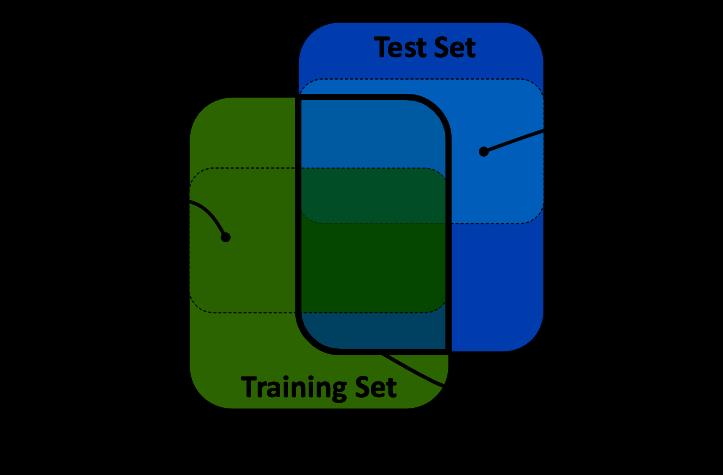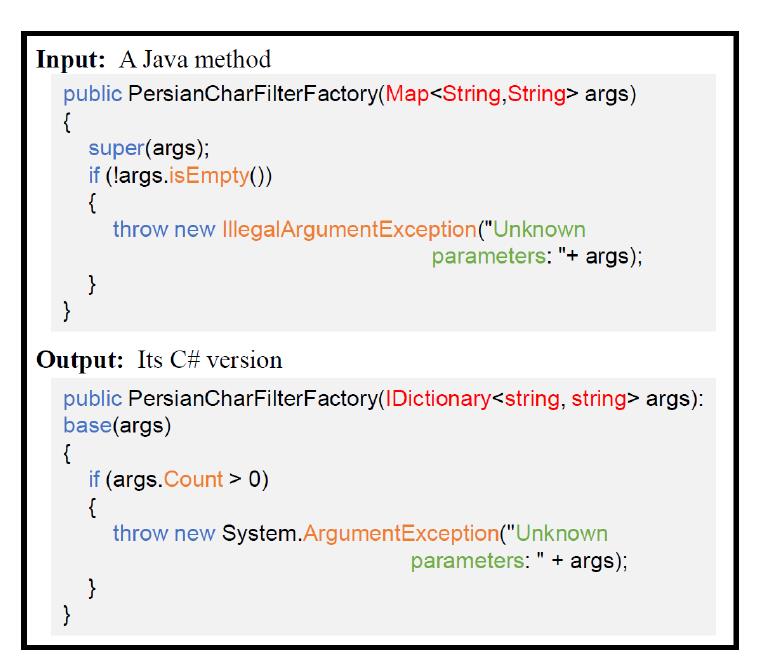代码智能:问题与解法
Posted Jtag特工
tags:
篇首语:本文由小常识网(cha138.com)小编为大家整理,主要介绍了代码智能:问题与解法相关的知识,希望对你有一定的参考价值。
代码智能:问题与解法
在基于预训练大模型引发自然语言处理革命的今天,代码智能技术也在迅速跟进发展。
那么,代码智能主要在做一些什么样的事情呢?可能很多同学会有比较科幻的想法,比如程序员要失业了之类的。
但是,其实很多工作并没有那么神秘,非常基础。那么我们用代码智能要解决什么问题呢?
- 判断两段代码是不是实现相似的功能
- 搜索跟当前代码段最相似的代码
- 检测代码是否有bug
- 自动修复代码中的bug
- 给一段代码自动写注释
- 根据文本推荐最相似的代码段
- 根据文本生成代码
看了之后是不是觉得更玄幻了?这么困难的问题怎么搞得定?
诚实地讲,这其中的每个子问题都很困难,就算是人类学习起来也很困难。
不过,正像是人类也是一步一步学会的一样,机器也在不断地进步。我们需要的不一定是万能的机器神,也是和我们一样普通的机器人,它们有很大的局限,但是它们可以帮助我们减轻不少工作量。
而且,最后一节我们将揭晓,处理这么多如此复杂问题的方法,却非常简单,一把梭哈,我们只用一个模型就能搞定。

下面我们就详细看一看这些问题的细节。
问题:克隆检测 Clone Detection
万地高楼平地起,代码智能任务首先从克隆检测做起。
所谓克隆检测,就是寻找写法和功能上相似的代码。
不要小看代码重复,它会显著地降低代码智能训练的有效性。
我们看下图,训练集中有重复,测试集中有重复,它们的交集中仍然有重复,在论文《The Adverse Effects of Code Duplication in Machine Learning Models of Code》中有详细的分析。

预测两段代码是否相似
以下的例子来自BigCloneBench数据集. 论文地址在:https://arxiv.org/pdf/2002.08653.pdf
下面我们举几个例子来看什么算相似:
代码1:
private StringBuffer encoder(String arg) {
if (arg == null) {
arg = "";
}
MessageDigest md5 = null;
try {
md5 = MessageDigest.getInstance("MD5");
md5.update(arg.getBytes(SysConstant.charset));
} catch (Exception e) {
e.printStackTrace();
}
return toHex(md5.digest());
}
代码2:
public String kodetu(String testusoila) {
MessageDigest md = null;
try {
md = MessageDigest.getInstance("SHA");
md.update(testusoila.getBytes("UTF-8"));
} catch (NoSuchAlgorithmException e) {
new MezuLeiho("Ez da zifraketa algoritmoa aurkitu", "Ados", "Zifraketa Arazoa", JOptionPane.ERROR_MESSAGE);
e.printStackTrace();
} catch (UnsupportedEncodingException e) {
new MezuLeiho("Errorea kodetzerakoan", "Ados", "Kodeketa Errorea", JOptionPane.ERROR_MESSAGE);
e.printStackTrace();
}
byte raw[] = md.digest();
String hash = (new BASE64Encoder()).encode(raw);
return hash;
}
代码2的字符串是用巴斯克语写的。它们用的算法也有区别,判空和异常处理也有不同,但是我们认为它们是很类似的,属于克隆识别认为相同或高度相似的。
我们再看一对例子:
代码1:
public static void test(String args[]) {
int trace;
int bytes_read = 0;
int last_contentLenght = 0;
try {
BufferedReader reader;
URL url;
url = new URL(args[0]);
URLConnection istream = url.openConnection();
last_contentLenght = istream.getContentLength();
reader = new BufferedReader(new InputStreamReader(istream.getInputStream()));
System.out.println(url.toString());
String line;
trace = t2pNewTrace();
while ((line = reader.readLine()) != null) {
bytes_read = bytes_read + line.length() + 1;
t2pProcessLine(trace, line);
}
t2pHandleEventPairs(trace);
t2pSort(trace, 0);
t2pExportTrace(trace, new String("pngtest2.png"), 1000, 700, (float) 0, (float) 33);
t2pExportTrace(trace, new String("pngtest3.png"), 1000, 700, (float) 2.3, (float) 2.44);
System.out.println("Press any key to contiune read from stream !!!");
System.out.println(t2pGetProcessName(trace, 0));
System.in.read();
istream = url.openConnection();
if (last_contentLenght != istream.getContentLength()) {
istream = url.openConnection();
istream.setRequestProperty("Range", "bytes=" + Integer.toString(bytes_read) + "-");
System.out.println(Integer.toString(istream.getContentLength()));
reader = new BufferedReader(new InputStreamReader(istream.getInputStream()));
while ((line = reader.readLine()) != null) {
System.out.println(line);
t2pProcessLine(trace, line);
}
} else System.out.println("File not changed !");
t2pDeleteTrace(trace);
} catch (MalformedURLException e) {
System.out.println("MalformedURLException !!!");
} catch (IOException e) {
System.out.println("File not found " + args[0]);
}
;
}
代码2:
private static String loadUrlToString(String a_url) throws IOException {
URL l_url1 = new URL(a_url);
BufferedReader br = new BufferedReader(new InputStreamReader(l_url1.openStream()));
String l_content = "";
String l_ligne = null;
l_content = br.readLine();
while ((l_ligne = br.readLine()) != null) {
l_content += AA.SL + l_ligne;
}
return l_content;
}
这个虽然没有涉及小语种,但是明显代码长度差异巨大。不过,我们仍然认为它们是相似的。
我们看一对不相似的吧:
代码1:
private void setNodekeyInJsonResponse(String service) throws Exception {
String filename = this.baseDirectory + service + ".json";
Scanner s = new Scanner(new File(filename));
PrintWriter fw = new PrintWriter(new File(filename + ".new"));
while (s.hasNextLine()) {
fw.println(s.nextLine().replaceAll("NODEKEY", this.key));
}
s.close();
fw.close();
(new File(filename + ".new")).renameTo(new File(filename));
}
代码2:
public void transform(String style, String spec, OutputStream out) throws IOException {
URL url = new URL(rootURL, spec);
InputStream in = new PatchXMLSymbolsStream(new StripDoctypeStream(url.openStream()));
transform(style, in, out);
in.close();
}
不相似的就不解释了。
BigCloneBench数据集,就是提供了两段代码,以及它们是否相似的人工打标的结果。
数据分为train.txt, valid.txt, test.txt三个集合,它们的格式都是同样的:
idx1 idx2 0/1
其中idx1和idx2是两段代码在data.jsonl中的索引值,最后一个是它们是否相似的人工打标的值。
代码都保存在data.jsonl中,格式为:
{"func":"代码","idx":"idx值"}
我们以训练集train.txt为例,其前两行是这样的:
13988825 8660836 0
80378 18548122 1
13988825在data.jsonl中对应的结构是这样的:
{"func": " private void setNodekeyInJsonResponse(String service) throws Exception {\\n String filename = this.baseDirectory + service + \\".json\\";\\n Scanner s = new Scanner(new File(filename));\\n PrintWriter fw = new PrintWriter(new File(filename + \\".new\\"));\\n while (s.hasNextLine()) {\\n fw.println(s.nextLine().replaceAll(\\"NODEKEY\\", this.key));\\n }\\n s.close();\\n fw.close();\\n (new File(filename + \\".new\\")).renameTo(new File(filename));\\n }\\n", "idx": "13988825"}
8660836对应的是:
{"func": " public void transform(String style, String spec, OutputStream out) throws IOException {\\n URL url = new URL(rootURL, spec);\\n InputStream in = new PatchXMLSymbolsStream(new StripDoctypeStream(url.openStream()));\\n transform(style, in, out);\\n in.close();\\n }\\n", "idx": "8660836"}
而它们的结果是不相似。大家看到,这个例子就是刚才上面我们写的第三个例子。
搜索跟当前代码段语义最相似的代码段
这个我们使用北大李戈李师团队的POJ-104数据集。
这个数据集需要到https://drive.google.com/uc?id=0B2i-vWnOu7MxVlJwQXN6eVNONUU去下载。
每个代码段用一个index来描述,然后code字段是完整的代码。我们来看个例子:
{
"label":"1",
"index":"0",
"code":"
int f(int a,int x)
{
int count=1,i;
for(i=x;i<a;i++)
if(a%i==0)
count+=f(a/i,i);
if(i==a)
return count;
else
return 0;
}
void main()
{
int n,a;
scanf(\\"%d\\",&n);
for(;n>0;n--)
{
scanf(\\"%d\\",&a);
if(a==1||a==2)
printf(\\"1\\
\\");
else
printf(\\"%d\\
\\",f(a,2));
}
}
"
}
然后,这个任务的目的就是求出针对某一段代码最相似的代码段。以取top 2为例:输出的样例如下:
{"index": "0", "answers": ["3", "2"]}
{"index": "1", "answers": ["0", "4"]}
{"index": "2", "answers": ["0", "1"]}
{"index": "4", "answers": ["1", "5"]}
{"index": "3", "answers": ["4", "2"]}
{"index": "5", "answers": ["4", "3"]}
也就是说,针对于代码index 0, 最相似的代码段是 index 3和2.
index 3是这样的:
void qut(int a,int b); //????
int num=0; //?????????
int main()
{
int i,n,g[1000]; //?????????
cin>>n;
for(i=0;i<n;i++) //??????
cin>>g[i];
for(i=0;i<n;i++)
{
qut(g[i],1); //????
cout<<num<<endl;
num=0;
}
return 0;
}
void qut(int a,int b)
{
int i;
if (a>=b)
{
num++;
if (b==1)
b++;
for (i=b;i<=a;i++)
{
if (a%i==0)
{
qut(a/i,i); //??a%i==0,??
}
}
}
}
问题:缺陷检测
缺陷检测的数据集非常简单粗暴,就是一段打标的代码,标识是不是有漏洞。
我们看个有漏洞的例子:
{
"project":"FFmpeg",
"commit_id":"aba232cfa9b193604ed98f3fa505378d006b1b3b",
"target":1,
"func":"static int r3d_read_rdvo(AVFormatContext *s, Atom *atom)
{
R3DContext *r3d = s->priv_data;
AVStream *st = s->streams[0];
int i;
r3d->video_offsets_count = (atom->size - 8) / 4;
r3d->video_offsets = av_malloc(atom->size);
if (!r3d->video_offsets)
return AVERROR(ENOMEM);
for (i = 0; i < r3d->video_offsets_count; i++) {
r3d->video_offsets[i] = avio_rb32(s->pb);
if (!r3d->video_offsets[i]) {
r3d->video_offsets_count = i;
break;
}
av_dlog(s, \\"video offset %d: %#x\\
\\", i, r3d->video_offsets[i]);
}
if (st->r_frame_rate.num)
st->duration = av_rescale_q(r3d->video_offsets_count,
(AVRational){st->r_frame_rate.den,
st->r_frame_rate.num},
st->time_base);
av_dlog(s, \\"duration %\\"PRId64\\"\\
\\", st->duration);
return 0;
}
",
"idx":5
}
信息就这么多,至于哪行是什么问题,训练集中没有。
当然,数据集里大部分还是没有漏洞的,比如第一条:
{"project": "FFmpeg", "commit_id": "973b1a6b9070e2bf17d17568cbaf4043ce931f51", "target": 0, "func": "static av_cold int vdadec_init(AVCodecContext *avctx)\\n\\n{\\n\\n VDADecoderContext *ctx = avctx->priv_data;\\n\\n struct vda_context *vda_ctx = &ctx->vda_ctx;\\n\\n OSStatus status;\\n\\n int ret;\\n\\n\\n\\n ctx->h264_initialized = 0;\\n\\n\\n\\n /* init pix_fmts of codec */\\n\\n if (!ff_h264_vda_decoder.pix_fmts) {\\n\\n if (kCFCoreFoundationVersionNumber < kCFCoreFoundationVersionNumber10_7)\\n\\n ff_h264_vda_decoder.pix_fmts = vda_pixfmts_prior_10_7;\\n\\n else\\n\\n ff_h264_vda_decoder.pix_fmts = vda_pixfmts;\\n\\n }\\n\\n\\n\\n /* init vda */\\n\\n memset(vda_ctx, 0, sizeof(struct vda_context));\\n\\n vda_ctx->width = avctx->width;\\n\\n vda_ctx->height = avctx->height;\\n\\n vda_ctx->format = 'avc1';\\n\\n vda_ctx->use_sync_decoding = 1;\\n\\n vda_ctx->use_ref_buffer = 1;\\n\\n ctx->pix_fmt = avctx->get_format(avctx, avctx->codec->pix_fmts);\\n\\n switch (ctx->pix_fmt) {\\n\\n case AV_PIX_FMT_UYVY422:\\n\\n vda_ctx->cv_pix_fmt_type = '2vuy';\\n\\n break;\\n\\n case AV_PIX_FMT_YUYV422:\\n\\n vda_ctx->cv_pix_fmt_type = 'yuvs';\\n\\n break;\\n\\n case AV_PIX_FMT_NV12:\\n\\n vda_ctx->cv_pix_fmt_type = '420v';\\n\\n break;\\n\\n case AV_PIX_FMT_YUV420P:\\n\\n vda_ctx->cv_pix_fmt_type = 'y420';\\n\\n break;\\n\\n default:\\n\\n av_log(avctx, AV_LOG_ERROR, \\"Unsupported pixel format: %d\\\\n\\", avctx->pix_fmt);\\n\\n goto failed;\\n\\n }\\n\\n status = ff_vda_create_decoder(vda_ctx,\\n\\n avctx->extradata, avctx->extradata_size);\\n\\n if (status != kVDADecoderNoErr) {\\n\\n av_log(avctx, AV_LOG_ERROR,\\n\\n \\"Failed to init VDA decoder: %d.\\\\n\\", status);\\n\\n goto failed;\\n\\n }\\n\\n avctx->hwaccel_context = vda_ctx;\\n\\n\\n\\n /* changes callback functions */\\n\\n avctx->get_format = get_format;\\n\\n avctx->get_buffer2 = get_buffer2;\\n\\n#if FF_API_GET_BUFFER\\n\\n // force the old get_buffer to be empty\\n\\n avctx->get_buffer = NULL;\\n\\n#endif\\n\\n\\n\\n /* init H.264 decoder */\\n\\n ret = ff_h264_decoder.init(avctx);\\n\\n if (ret < 0) {\\n\\n av_log(avctx, AV_LOG_ERROR, \\"Failed to open H.264 decoder.\\\\n\\");\\n\\n goto failed;\\n\\n }\\n\\n ctx->h264_initialized = 1;\\n\\n\\n\\n return 0;\\n\\n\\n\\nfailed:\\n\\n vdadec_close(avctx);\\n\\n return -1;\\n\\n}\\n", "idx": 0}
推理搞起来也是十分省事了,就是对应每个index给个0或1的结果:
0 0
1 1
2 1
3 0
4 0
问题:代码自动修复
有了识别代码漏洞的,更进一步就是学习自动修复代码的了。
代码自动修复的题目也很简单,一段是有bug的代码,另一段是修复之后的代码。
我们来看一个例子:
有bug的代码是这样的:
public java.lang.String METHOD_1 ( ) { return new TYPE_1 ( STRING_1 ) . format ( VAR_1 [ ( ( VAR_1 . length ) - 1 ) ] . getTime ( ) ) ; }
修复之后是这样子的:
public java.lang.String METHOD_1 ( ) { return new TYPE_1 ( STRING_1 ) . format ( VAR_1 [ ( ( type ) - 1 ) ] . getTime ( ) ) ; }
也真难为算法了,人看起来都有点费事。
问题:代码互译
比如实现C#语言和Java语言的互译。我们只要有一系列代码的C#写法和Java写法,就可以进行学习进行互译。
我们来看一对例子。
先看C#代码:
public virtual ListSpeechSynthesisTasksResponse ListSpeechSynthesisTasks(ListSpeechSynthesisTasksRequest request){
var options = new InvokeOptions();
options.RequestMarshaller = ListSpeechSynthesisTasksRequestMarshaller.Instance;
options.ResponseUnmarshaller = ListSpeechSynthesisTasksResponseUnmarshaller.Instance;
return Invoke<ListSpeechSynthesisTasksResponse>(request, options);
}
对应的Java
public ListSpeechSynthesisTasksResult listSpeechSynthesisTasks(ListSpeechSynthesisTasksRequest request) {
request = beforeClientExecution(request);
return executeListSpeechSynthesisTasks(request);
}

问题:给代码写注释
在训练素材中,有代码和注释,这个任务的目的为新代码写注释。评价指标是对于生成的注释的语言准确度。
这个我们使用CodeSearchNet数据集。
这个数据集中的每条记录的格式如下:
- repo: 仓库名
以上是关于代码智能:问题与解法的主要内容,如果未能解决你的问题,请参考以下文章